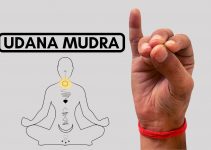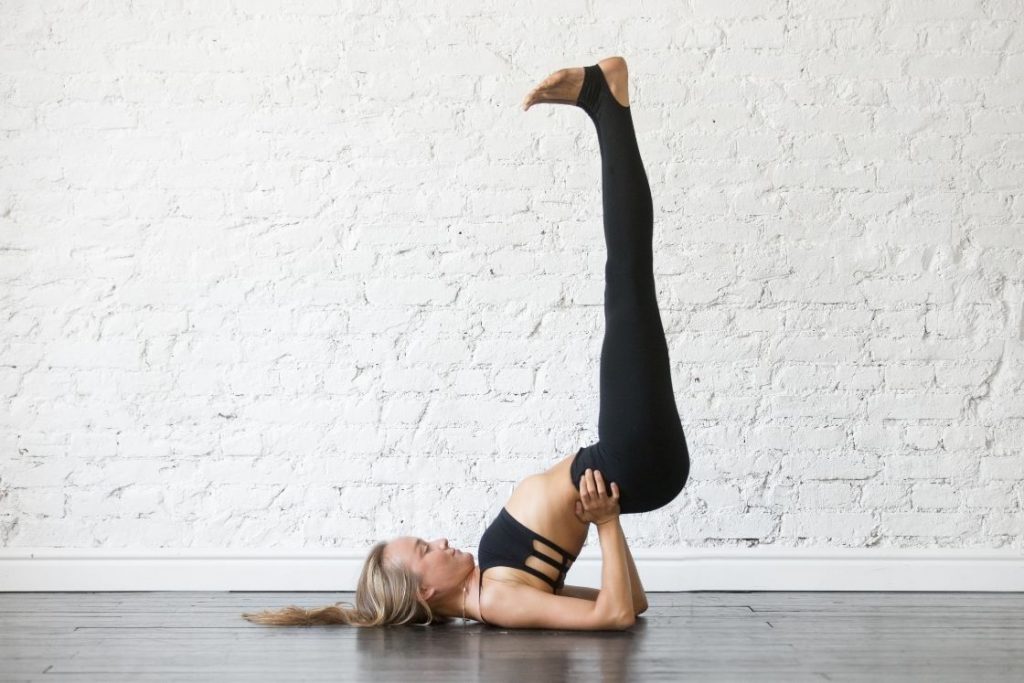
If we see the traditional texts of yoga, Viparita Karani is described as a type of Kaya yoga mudra.
Unlike simple hand mudras of yoga, In Kaya mudra, the whole body with breathing and concentration practice is combined together to perform a mudra.
The body position in Viparita Karani mudra looks similar to other inverted yoga poses like Sarvangasana (Shoulder Stand) and Sirsasana (Headstand). So often it’s also referred as Viparita Karani Asana.
Many physical effects of Viparita Karani have observed by yogis including anti-aging, constipation reliever, appetite increase, fresh blood circulation, and glow in the face.
Viparita Karani Meaning
This Sanskrit term Viparita means “Reverse” and Karani means “Action to achieve a work”. Summing up the meaning of root terms, Viparita Karani means the “Action of reversing”.
By means of reversing action, here in Viparita Karani Mudra, the flow of energy is reversed; energy in the form Soma (fluid).
In Viparita Karani Mudra, the natural upright body position is brought into a reversed position where the back is supported using hands at an angle of 60 degrees. This position of ‘head down and legs up’ allow fluids to flow back toward the head from where it actually originated.
Difference Between Viparita Karani and Sarvangasana

It should be noted here, Viparita Karani is a flow reversing process, not just an inversion posture like Sarvangasana. Inversion means “opposite to the flow” whereas reversing the flow means “going back to the origin”.
It shows, Viparita Karani clearly follows the mechanism of mudra. Like any other mudras, it creates a loop of energy in the body by reversing the flow of fluids back to the head, it stops energy dissipation.
Viparita Karani
- In Viparita Karani, the back is not completely straight. It’s tilted at an angle of 45 to 60 degrees.
- Here the flexibility in the back angle keep throat muscles relaxed – so it allows energy to move into the Bindu chakra in the head.
- Viparita Karani also called half shoulder stand as shoulder doesn’t bear that much pressure here.
Sarvangasana
- In Sarvangasana, the back and legs are at 90 degrees from the floor.
- The steep angle creates pressure around the throat muscles – so restrict energy flow to the throat chakra only.
- Sarvangasana is shoulder stand as almost all bodyweight goes to the shoulders.
Viparita Karani Practice Guide
Follow the points below for safely practice Viparita Karani and its legs up the wall variation.
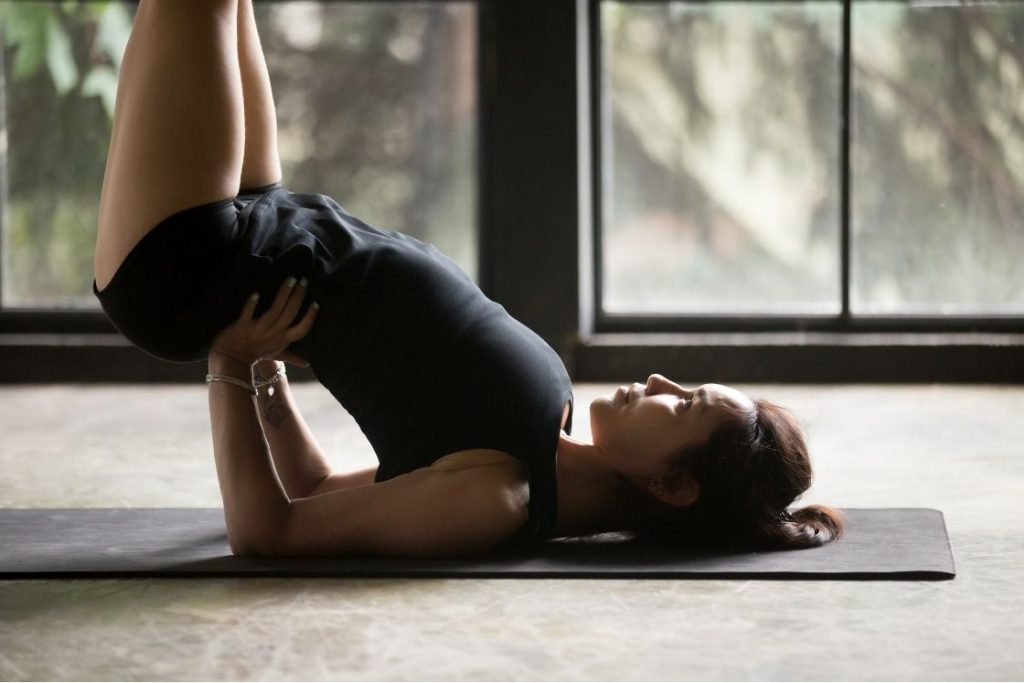
Precautions & Contraindications
- Before performing Viparita Karani, make sure your bowels are empty. Especially when you have constipation, do laghoo shankha prakshalana before it.
- This inversion posture should be avoided when having high blood pressure, heart disease problems, and thyroid disorders.
- If you do Viparita Karani for an extended period, maintain a gap of 6 hours between the practice and your meal.
- Come out of the pose slowly if you feel the heavy head.
Follow the procedure below to perform Viparita Karani mudra;
How to Do Viparita Karani (Steps)
- Come over your mat or on a flat surface and lay down on your back. Bring your hands resting next to the hips.
- Slowly raise your legs up bending from the hip level, keep raising until the legs don’t get perpendicular to the floor.
- Now push your hands under the lower back (waist level) and grab your waist from the back to support it.
- Gradually inhale, hold the breath in and with hands support, raise your legs and lower back further up.
- Use your elbows and hands support together to raise up your lower back including the whole trunk. Your trunk should be at an approx angle of 45 degrees from the floor.
- Once the trunk fixed, straighten your legs in the air so it comes again at 90 degrees from the floor.
- In the final position, your inverted bodyweight should be transferred to the shoulders.
- If you can do, include Ujjayi breathing and khechari mudra in this final position. With every breath in, concentrate on Manipura chakra and at the end of inhalation, bring your awareness to the throat, Vishudhi chakra.
Hold the pose as per your comfortability. Minimum of 3 minutes is enough for beginners while-as advanced yogis can hold it for 3 hours (only under the guidance of a guru).
Release
- Firstly lower the back slowly and remove the hand’s support from the back.
- Rest your palms on the floor.
- Then lower the legs to the floor without bending them.
Variation
Viparita Karani asana actually becomes a gentle restorative pose when performed in its variation.
Legs up the wall is a very common variation of it. It’s a very supportive method for beginners who can’t hold Viparita Karani for a couple of minutes. Here’s how to perform it;
Legs up the wall
In legs up the wall, you will need folded blanket or a bolster to support your back.
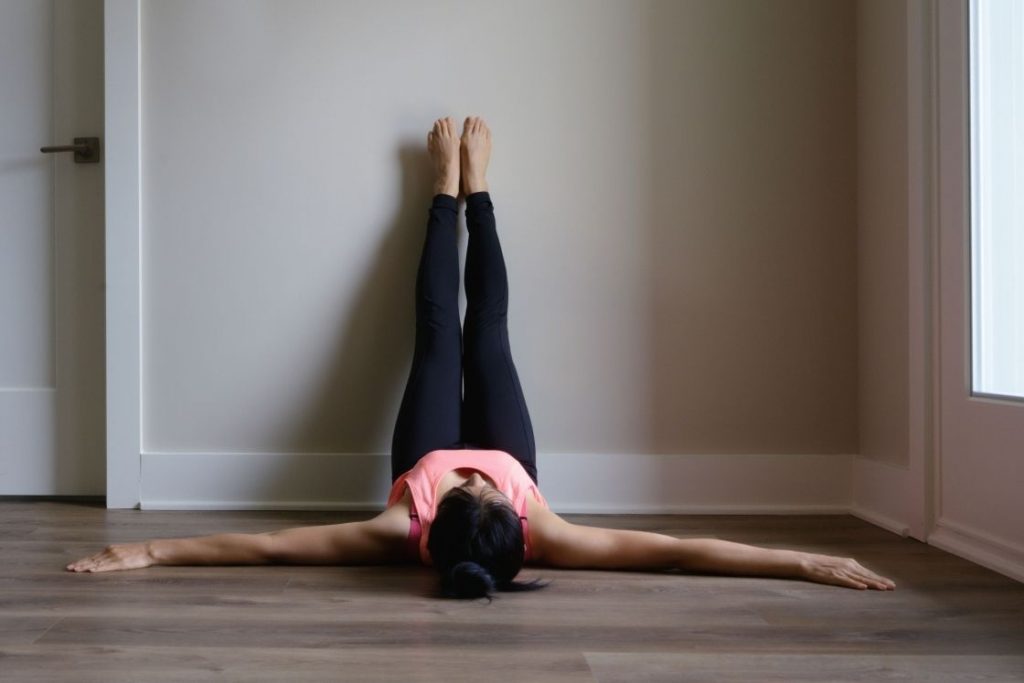
- To begin with, place your support a few inches away from the wall. Sit sideways legs extending straight in the space between your support and wall.
- With exhalation, turn your legs up onto the wall and rest shoulders and head on the floor. Adjust your scrum on the ground (forward and backward) so hips comes directly under the raised legs.
- Further adjust your supine trunk on the floor so the folded blanket or bolster support your lower back.
- Your back of legs should be completely rest against the wall.
- Hands can be rested sideways or simply placed on abdomen.
Best time to Perform Viparita Karani
Like other inverted type yoga poses, Viparita Karani is best to practice in the morning time after evacuating the bowels and taking the shower. During the daytime, metabolic and other activities of the body are already at its peak. In this condition reversing the body natural flow will bring more harmful effects rather than any benefit.
However, one can do it in the afternoon, after 3 hours of a normal meal. Moreover, it should begin after 10 minutes of Shavasana rest.
Therapeutic Applications
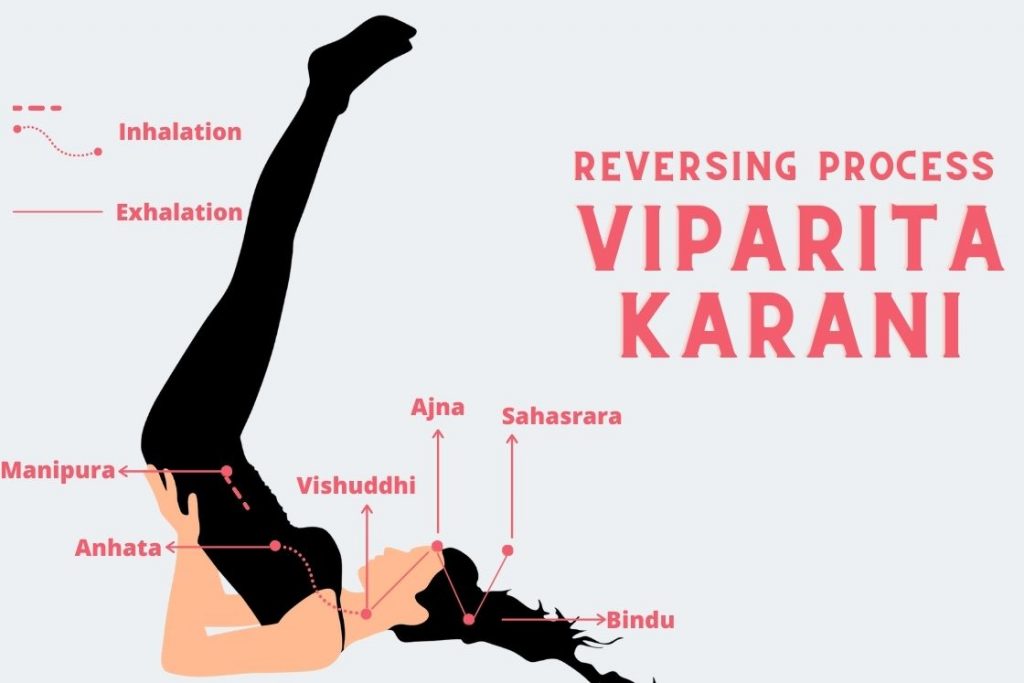
Viparita Karani has many therapeutic applications because of its inversion and flow reversing process.
In the kriya yoga, it’s explained; aging is the result of the downward flow of nectar (fluid) from Bindu (in the head) to Manipura Chakra (in the navel). Viparita Karani reverses this flow of nectar back to the Bindu, hence works anti-aging exercise.
- Viparita Karani increases the blood flow to the brain so effective in the treatment of cerebral insufficiency and senile dementia.
- Cures hemorrhoids, varicose veins, and a certain type of hernia.
- In Hatha Yoga Pradipika (3.82), it’s said; “After six months of practice, grey hairs and wrinkles become inconspicuous. One who practices Viparita Karani for three hours conquers death.”
- However, modern teachers also suggest Viparita Karani can be practiced to overcome premenstrual syndrome, menopause, menstrual cramps [efn_note] A Single Case Study on Menstrual Disorder and with Yoga Therapy http://www.indianjournals.com/ijor.aspx?target=ijor:ijner&volume=3&issue=1&article=012 [/efn_note], and insomnia.
- the pressure exerted around throat muscles in this mudra stimulates the thyroid gland. It rebalances the functions of hypoactive thyroid.
Viparita Karani Benefits
- ‘Legs up the wall’ variation of Viparita Karani relaxes lower body muscles and release the tension from cramped feet & legs.
- Activates throat chakra which gives you the ability to better express yourself, your emotions, and creativity.
- Increases the secretions of digestive juices so the digestion process. An increase in appetite also can be experienced.
- Increases metabolism in body cells results in a reduction in fat around the waist in obese people [efn_note] Management of obesity through specific yogic procedure https://www.researchgate.net/profile/Yogesh_Deole2/publication/265026464 [/efn_note].
- when the head turns upside down, then pooled cellular fluid aggregated in lower body parts comes into the circulation.
- It restores the vascular tone and elasticity that prevents atherosclerosis (a condition of fats, cholesterol, and other substances accumulation in artery walls).
- Helpful in soothing the mild backache.
- Gives a gentle stretch to the back of the neck, legs, front torso & pelvis.
- A study suggests [efn_note] Effects of Yogic Practices on Different Organs of an Athlete http://citeseerx.ist.psu.edu/viewdoc/download?doi=10.1.1.681.4563&rep=rep1&type=pdf [/efn_note] inversion poses like Viparita Karani strengthens the heart muscle, thus resulting in better circulation and less possibility of heart disease.


